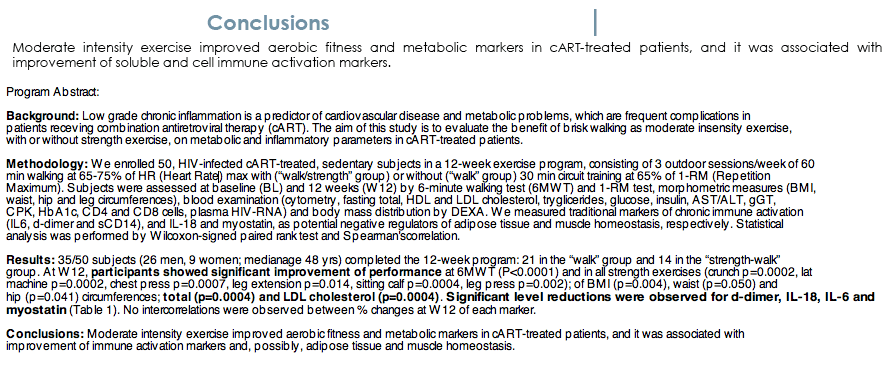 |
 |
 |
| |
Brisk Walking Improves Inflammatory Markers in cART-Treated Patients
|
| |
| |
Reported by Jules Levin
CROI 2014 March 3-6 Boston, MA
Valeria Longo1, Matteo Bonato2, Laura Galli1, Simona Bossolasco1, Gaspare Pavei3, Adriano Lazzarin1, Giampiero Merati2, Antonio La Torre2, Paola Cinque1
1San Raffaele Scientific Institute, Infectious Diseases, Milano, ITALY, 2Universita degli Studi di Milano, Biomedical Sciences for Health, Milano, ITALY, 3Universita degli Studi di Milano, Pathophysiology and Transplantation Department, Milano, ITALY
Program Abstract:
Background: Low grade chronic inflammation is a predictor of cardiovascular disease and metabolic problems, which are frequent complications in
patients receving combination antiretroviral therapy (cART). The aim of this study is to evaluate the benefit of brisk walking as moderate insensity exercise,
with or without strength exercise, on metabolic and inflammatory parameters in cART-treated patients.
Methodology: We enrolled 50, HIV-infected cART-treated, sedentary subjects in a 12-week exercise program, consisting of 3 outdoor sessions/week of 60
min walking at 65-75% of HR (Heart Rate) max with ("walk/strength" group) or without ("walk" group) 30 min circuit training at 65% of 1-RM (Repetition
Maximum). Subjects were assessed at baseline (BL) and 12 weeks (W12) by 6-minute walking test (6MWT) and 1-RM test, morphometric measures (BMI,
waist, hip and leg circumferences), blood examination (cytometry, fasting total, HDL and LDL cholesterol, tryglicerides, glucose, insulin, AST/ALT, gGT,
CPK, HbA1c, CD4 and CD8 cells, plasma HIV-RNA) and body mass distribution by DEXA. We measured traditional markers of chronic immune activation
(IL6, d-dimer and sCD14), and IL-18 and myostatin, as potential negative regulators of adipose tissue and muscle homeostasis, respectively. Statistical
analysis was performed by Wilcoxon-signed paired rank test and Spearman'scorrelation.
Results: 35/50 subjects (26 men, 9 women; medianage 48 yrs) completed the 12-week program: 21 in the "walk" group and 14 in the "strength-walk"
group. At W12, participants showed significant improvement of performance at 6MWT (P<0.0001) and in all strength exercises (crunch p=0.0002, lat
machine p=0.0002, chest press p=0.0007, leg extension p=0.014, sitting calf p=0.0004, leg press p=0.002); of BMI (p=0.004), waist (p=0.050) and
hip (p=0.041) circumferences; total (p=0.0004) and LDL cholesterol (p=0.0004). Significant level reductions were observed for d-dimer, IL-18, IL-6 and
myostatin (Table 1). No intercorrelations were observed between % changes at W12 of each marker.
Conclusions: Moderate intensity exercise improved aerobic fitness and metabolic markers in cART-treated patients, and it was associated with
improvement of immune activation markers and, possibly, adipose tissue and muscle homeostasis.



http://en.wikipedia.org/wiki/CD38
The loss of CD38 function is associated with impaired immune responses, metabolic disturbances, and behavioral modifications including social amnesia possibly related to autism.[5][6]
The CD38 protein is a marker of cell activation. It has been connected to HIV infection, leukemias, myelomas, solid tumors, type II diabetes mellitus and bone metabolism, as well as some genetically determined conditions.
CD38 produces an enzyme which regulates the release of oxytocin within the central nervous system.[6]
http://en.wikipedia.org/wiki/HLA-DR

The primary function of HLA-DR is to present peptide antigens, potentially foreign in origin, to the immune system for the purpose of eliciting or suppressing T-(helper)-cell responses that eventually lead to the production of antibodies against the same peptide antigen. Antigen presenting cells (macrophages, B-cells and dendritic cells) are the cells in which DR are typically found. Increased abundance of DR 'antigen' on the cell surface is often in response to stimulation, and, therefore, DR is also a marker for immune stimulation.



|
| |
|
 |
 |
|
|